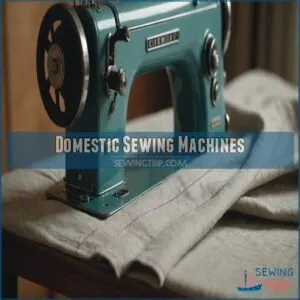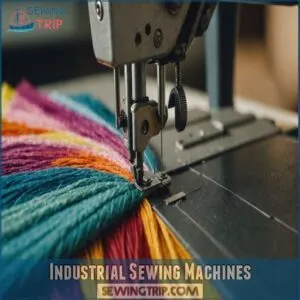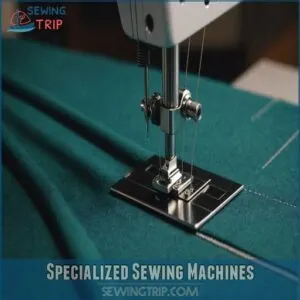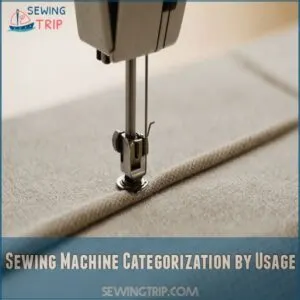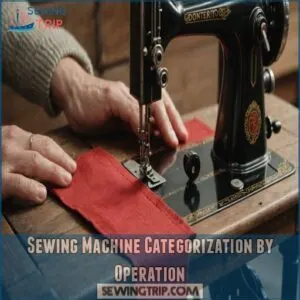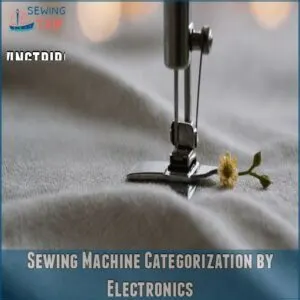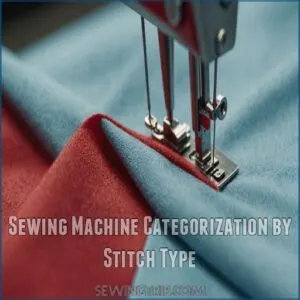This site is supported by our readers. We may earn a commission, at no cost to you, if you purchase through links.
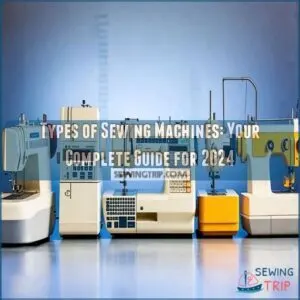 Exploring the types of sewing machines is like opening a treasure chest for fabric artists. You’ve got mechanical machines, trusty as your favorite old sneakers, which are perfect for straightforward needs.
Exploring the types of sewing machines is like opening a treasure chest for fabric artists. You’ve got mechanical machines, trusty as your favorite old sneakers, which are perfect for straightforward needs.
Then, there are computerized machines—practically your sewing sidekick with pre-programmed stitches.
Don’t forget treadle machines; they’ll give your calf muscles a workout while sewing up a storm.
In the specialized corner, embroidery machines add flair, while quilting ones tackle the heftiest quilts. Industrial types are the heavy lifters, built for serious fabric feats.
Now, ready to stitch up your knowledge with expert insights and tips on choosing your perfect machine?
Table Of Contents
- Key Takeaways
- Domestic Sewing Machines
- Industrial Sewing Machines
- Specialized Sewing Machines
- Sewing Machine Categorization by Usage
- Sewing Machine Categorization by Operation
- Sewing Machine Categorization by Electronics
- Sewing Machine Categorization by Stitch Type
- Frequently Asked Questions (FAQs)
- Conclusion
Key Takeaways
- You’ll find a wide variety of sewing machines to suit your needs, including mechanical, computerized, embroidery, quilting, and industrial types.
- Domestic sewing machines are versatile and budget-friendly, perfect for beginners exploring basic to advanced stitching at home.
- Specialized machines like sergers, cover stitch, and embroidery units offer tailored features for precise tasks, enhancing your creative projects.
- Understanding each machine type helps you make informed choices, ensuring you have the right tools for everything from simple repairs to detailed embroidery and heavy-duty sewing.
Domestic Sewing Machines
When you’re starting your sewing journey, domestic sewing machines are your trusty companions, offering everything from basic straight stitching to more advanced embroidery options.
They’re like the Swiss Army knife of sewing tools—ideal for crafting comfy quilts, fixing hems, or even putting your unique spin on homemade fashion, all without breaking the bank.
Mechanical Sewing Machine
Imagine a trusty sidekick for your sewing adventures that offers a simpler, more hands-on experience compared to computerized machines, making it a great choice for beginners who want to master the fundamentals without getting overwhelmed, and you can find more information on the best mechanical sewing machines for beginners here. the mechanical sewing machine.
It’s perfect for beginners, offering basic stitches without breaking the bank.
Brands like Singer and Janome offer budget options that are easy on the wallet.
With simple knobs and levers, you can tackle basic projects.
Just remember, regular maintenance keeps it humming smoothly for your next creative escapade.
Manual Sewing Machine (treadle)
After mastering mechanical sewing machines, you’ll cherish the charm and workout a manual sewing machine (treadle) offers.
Imagine transforming antique treadles into your workout buddy.
Here’s why:
- Treadle History: Relive tradition.
- Treadle Maintenance: Keep it fit.
- Treadle Accessories: Personalize your experience.
- Treadle vs. Electric: Choose power or nostalgia.
Computerized Sewing Machine
Many computerized sewing machines offer incredible features! You’ll find an LCD screen for easy stitch selection, plus automated functions like needle threading.
Explore embroidery software options and compare prices from various sewing machine brands.
Learning resources abound online and in sewing machine manuals.
Remember regular sewing machine maintenance is key to extending its lifespan. Don’t forget to research sewing machine functions before buying!
Quilting Sewing Machine
Thinking of immersing yourself in quilting? Quilting sewing machines are your best bet, offering features like an extended arm for maneuvering large quilts and adjustable stitch lengths.
Brands like Janome and Brother pack in nifty accessories and techniques.
Unlike their long-arm cousins, these machines fit snugly in any nook, letting you express your creativity right from your cozy corner.
Embroidery Machine
Quilting got you covered, but what if you crave flair?
Embroidery machines transform plain fabric into artistic canvases.
You’ll explore various embroidery machine types, each offering unique features.
With embroidery design software, you create vibrant patterns while attachments add versatility.
Regular maintenance keeps it humming smoothly.
Whether troubleshooting or choosing new accessories, it’s about nurturing your creative freedom!
Industrial Sewing Machines
When you’re tackling big projects or sewing through thick materials, machines featuring a sump-type oil bath like the Singer 241-12 Commercial can really make a difference, industrial sewing machines are your heavy-duty best friends—they’re like the superheroes of the sewing world, built for speed and precision.
Whether you’re handling leather jackets or canvas tents, these machines won’t break a sweat, saving you time and giving you those perfect, even stitches that make your handiwork stand out.
Heavy-duty Sewing Machine
Curious about tackling heavy-duty sewing projects? Industrial sewing machines are your best friends.
They’re designed for power and precision, perfect for heavy fabrics.
Here’s why they’re fabulous:
- Speed: Complete tasks in a flash.
- Durability: Built to last through thick and thin.
- Versatility: Handle leather, canvas, and more effortlessly.
Chain Stitch Machine
Chain stitch machines are your go-to for unique, stretchy seams.
Unlike lockstitch, they use a single looping thread.
Imagine sewing thick fabrics like denim without breaking a sweat!
Here’s a quick look:
| Feature | Chain Stitch | Lockstitch |
|---|---|---|
| Thread Use | Single | Double |
| Best For | Knit Fabric | Woven Fabric |
| Maintenance Frequency | Low | Medium |
Blind Stitch Machine
If you’ve ever wondered how hems look seamless, thank the blind stitch machine.
Unlike chain stitch machines, these gems create invisible hems on everything from pants to skirts.
Perfect for hemming apparel with a smooth, professional look, these machines are indispensable for garment makers.
When comparing prices or features, know these are your go-to for flawless finishes.
Cover Stitch Machine
Need a professional finish on your knit projects? A cover stitch machine is your new best friend! It creates those gorgeous, stretchy seams perfect for leggings or t-shirts.
Unlike sergers, a cover stitch machine excels at decorative seams and adding a touch of flair. You’ll love the clean, flat seams it produces on stretchy fabrics.
This machine’s a game-changer, offering control and precision. Consider it a serious upgrade from your basic sewing machine—you’ll gain mastery and freedom over your projects.
Sergers, Overlock, and Overedge Machine
While cover stitch machines handle hems beautifully, sergers, overlock, and overedge machines master seam finishes.
These powerhouses trim and seal raw fabric edges simultaneously, perfect for knits and trickier materials.
Imagine tackling those pesky unraveling fabric edges with ease!
For professional-looking finishes, the best serger sewing machines offer features like automatic tension control and differential feed, such as those found in the top-rated serger machines.
- Machine Types: Industrial and domestic options available.
- Fabric Compatibility: Ideal for knits and wovens.
- Thread Capacity: Uses 2 to 8 threads.
- Versatility: Great for creative finishes and durability.
Specialized Sewing Machines
When you’re ready to sew like a pro, specialized sewing machines are your secret weapon for tackling unique tasks with precision.
Whether you’re creating neat buttonholes, attaching buttons in record time, or reinforcing garments with sturdy bar-tack stitches, these machines handle the heavy lifting so you can focus on the fun part—crafting your masterpiece!
Lockstitch Sewing Machines
For those who yearn for flawless seams, lockstitch sewing machines are your trusty sidekick.
These machines use two threads to create a stitch that’s consistent on both sides—ideal for different projects like quilting or heavy fabrics.
Beginners love them for their reliability, but don’t forget regular maintenance! It’s like giving your car an oil change—just less messy.
Buttonholing Machines
Ever wondered about the magic behind perfect buttonholes?
Enter the buttonholing machine, your go-to for crafting flawless, consistent holes every time.
Whether you’re eyeing the best buttonhole machines or seeking buttonhole stitch variations, these specialized sewing tools are essential for professionals.
Maintain them well, and they’ll work wonders, saving you time and giving your projects that polished look.
Button Attachment Machines
Sewing buttons can feel like threading a needle in a haystack, especially when speed and precision matter.
With button attachment machines, you breeze through it, attaching various button types with ease.
Whether in domestic use or a buzzing industrial setting, these machines cut down time remarkably.
Just watch out for occasional tangles—because nobody’s got time for button blues!
Bar-Tacking Sewing Machines
Bar-tacking sewing machines are your secret weapon for reinforcing garments.
By creating dense stitches, they strengthen vulnerable points like pocket corners and belt loops.
Think of them as the superheroes of sewing, swooping in to provide durability where it’s needed most.
They offer exceptional strength and come in various patterns, including those used for accent stitching on jeans or bags, such as those created using Heavy-duty Industrial Sewing Machines.
With various machine types and settings, they’ll save you from constant repairs, offering benefits aplenty without breaking a sweat!
Sewing Machine Categorization by Usage
Let’s talk about how sewing machines are used! You’ll find that they’re broadly categorized into domestic models, perfect for home projects, and industrial models, built for serious, heavy-duty sewing.
Domestic Model Sewing Machine
Imagine this: You’re diving into domestic model sewing machines, perfect for your beginner sewing projects.
They’re your go-to for crafting clothes, accessories, and home décor with ease.
Here’s why you’ll love them:
- Versatile Stitch Options: Ideal for straight to zig-zag stitching.
- User-Friendly Design: Great for novices.
- Compact Size: Fits snugly in tight spaces.
Industrial Model Sewing Machine
Ever tried sewing through leather?
Industrial sewing machines are your best friend for heavy-duty sewing applications.
They handle thick materials like a champ, producing excellent stitches at lightning speed.
You can find a variety of models from top industrial sewing machine brands at reliable sewing machine sources.
From flat bed to cylinder bed machines, there’s a model for every need.
Keep them running smoothly with regular maintenance.
Maintenance and repair aren’t just chores—they’re your sewing machine’s TLC, especially when working with a serger sewing machine that uses a blade to cut fabric as it sews, which requires periodic blade sharpening or replacement for optimal performance understanding serger sewing machines!
Sewing Machine Categorization by Operation
In terms of sewing machines, how they operate can make or break your project—trust me, trying to sew a stuffed dragon tail by hand is no walk in the park!
You’ll explore hand-operated, treadle, and electronic machines, each offering unique features and quirks that cater to different sewing needs and preferences.
Hand Operated Sewing Machine
You might appreciate the simplicity and charm of a hand operated sewing machine.
Perfect for vintage sewing enthusiasts and those who enjoy the historical touch, these machines require a bit of elbow grease.
Manual sewing machines, such as straight stitch machines, take extra time and effort, but it’s a rewarding skill for DIY projects and offers a unique control that modern machines can’t replicate.
Treadle Sewing Machine
The charm of the treadle sewing machine lies in its vintage vibe and eco-friendly operation.
It’s a foot-powered gem that doesn’t need electricity.
Here’s what you’ll love:
- Treadle history: a nod to simpler times.
- Treadle maintenance: keep it clean and oiled.
- Treadle repairs: often easy DIY fixes.
- Treadle advantages: perfect for regions with limited power sources.
Electronic Sewing Machine
Foot-powered wisdom meets electric ease in the world of electronic sewing machines.
Enjoy stitch options galore and tech-savvy features without breaking the bank.
Pros? Effortless control.
Cons? Price can inch up with brands offering fancy LCD screens.
You can find a great selection of touch screen sewing machines online, like those available at Touch Screen Sewing Machine stores like this.
Stitch your dreams with these whizzers!
| Feature | Details |
|---|---|
| Stitch Options | Numerous, including buttonholes |
| Price Range | $$ to $$$, depends on brand |
| Display Type | LCD screens and touch buttons |
Sewing Machine Categorization by Electronics
So, you’ve mastered the mechanics of different sewing machine operations. Now, let’s talk electronics. Moving on to electronic sewing machines opens up a whole new world of features and benefits. Electronic models offer more control and convenience than their mechanical counterparts. Think of it as upgrading from a standard car to a luxury model with all the bells and whistles.
If you’re looking to explore these features and benefits, consider checking out websites that sell a variety of electronic sewing machines online, such as those found through electronic sewing machines. Costs vary wildly depending on the brand and features. Top brands like Singer, Brother, and Janome offer a range of options. But what’re the key differences?
- Stitch Selection: Electronic machines boast a wider variety of stitches.
- Ease of Use: Electronic controls simplify adjustments.
- Advanced Features: Some models include things like automatic needle threading.
Ultimately, the best choice depends on your budget and sewing needs. Don’t be intimidated; it’s easier than you think to find the perfect electronic sewing machine for you.
Sewing Machine Categorization by Stitch Type
When diving into sewing, you’ll find machines categorized by stitch type, each with its own charm and utility.
A lockstitch machine creates stitches resembling identical lines on both sides, perfect for durable seams with consistent stitch quality.
Let’s not forget the chain stitch machine, which loops threads for flexibility—useful for knit fabrics where you need a bit of stretch.
Then there’s the specialized blind stitch machine, great for those secretive hems that could win a game of hide-and-seek.
Crafting isn’t just about choosing fabric; it’s about picking the right stitch type for your project.
By understanding these machines, you’re not just stitching fabric; you’re stitching stories and solutions!
Frequently Asked Questions (FAQs)
How many types of sewing machines are there?
It’s like a jungle out there with sewing machines!
There are numerous types, including domestic, industrial, mechanical, electronic, computerized, embroidery, and quilting machines, each offering unique features to suit everything from hobby projects to high-volume production.
What can you do with a sewing machine?
You can create custom clothing, especially with specialized machines like the leather sewing machine, and repair or alter outfits, and stitch decorative items with a sewing machine.
Imagine crafting personalized gifts or designing home decor—all while enjoying a satisfying blend of creativity and practicality.
What is the best sewing machine for beginners?
When choosing a sewing machine, consider the differences between brands like Singer and Brother, which were compared in a review of Singer vs Brother Machines. They say "start where you are," and for beginners, a mechanical sewing machine like the Brother XM2701 is versatile and user-friendly.
It offers essential features, multiple stitch options, and affordability, making your sewing journey smooth and enjoyable.
Are all sewing machines equal?
Sewing machines vary wildly.
Some are basic, perfect for beginners.
Others are industrial powerhouses, built for serious projects.
Think of it like cars—you wouldn’t use a go-kart for a cross-country road trip, would you?
How do you classify a sewing machine?
If you own a DeLorean, classifying sewing machines can feel like time travel.
Consider purpose (domestic vs. industrial), operation (manual, electronic, computerized), and stitch type (lockstitch, chain).
Remember, each type suits different sewing tasks and expertise.
What is a basic mechanical sewing machine?
A basic mechanical sewing machine is great for beginners, offering features like adjustable settings and stitch variety. A basic mechanical sewing machine uses a motor to power gears and belts, letting you stitch with simple dials to adjust length and width.
It’s affordable, reliable, and perfect for beginners or basic sewing projects.
What are the 7 types of sewing machines?
Think of sewing machines like a toolbox for fabrics.
You’ve got mechanical, electronic, computerized, embroidery, serger, quilting, and industrial machines.
Each tool fits different tasks, from simple stitches to complex designs, making sewing magical.
What are the four types of sewing?
Sewing comes in four main types: hand sewing, machine sewing, embroidery, and quilting.
Each style brings unique flair and functionality, letting you create everything from simple repairs to elaborate artistic masterpieces.
Sew on and express yourself!
How many different kinds of sewing machines are there?
Imagine this: over 20 types of sewing machines exist, each designed for specific tasks.
From mechanical and computerized models to industrial and specialty machines like embroidery and sergers, there’s something for everyone.
Explore and discover your match!
What type of sewing machines do tailors use?
Tailors often use industrial sewing machines for speed and precision, especially heavy-duty ones for thick fabrics.
They might also use sergers for neat edges and blind stitch machines for invisible hems, creating professional, well-finished garments quickly.
How do you maintain a sewing machine?
Regularly oil it, clean the bobbin area, and check the needle. Don’t forget to replace the needle periodically! A well-maintained machine equals happy sewing!
What are common sewing machine troubleshooting tips?
Did you know 90% of sewing machine problems are solved with basic troubleshooting?
Check thread tension, use a fresh needle, clean lint, or rethread.
These simple steps prevent hours of frustration and keep creativity flowing.
How to choose the right sewing machine needle?
Choosing the right needle requires matching it to fabric type and thickness.
Use universal needles for cotton, ballpoint for knits, and sharp needles for silk.
Check the needle size—larger sizes handle thicker fabrics, like denim.
What accessories enhance sewing machine functionality?
Enhancing your sewing machine’s functionality involves adding accessories like walking feet for even fabric feeding, quilting feet for precision, stitch guides, and bobbin holders.
These tools make projects smoother, whether crafting quilts or just hemming pants.
How to safely store a sewing machine?
Keep your sewing machine safe and sound by covering it to shield from dust.
Store it in a dry spot, away from sunlight.
Unplug it when not in use, and consider a sturdy case for added protection.
Conclusion
Did you know that over 80% of sewing enthusiasts have more than one type of sewing machine?
This variety helps them tackle projects with the right tools.
By understanding the types of sewing machines—the trusty mechanical, the advanced computerized, and all the specialties in between—you can make informed choices that suit your creative needs.
Whether you’re quilting, embroidering, or just starting out, there’s a perfect fit out there to enhance your sewing experience.

